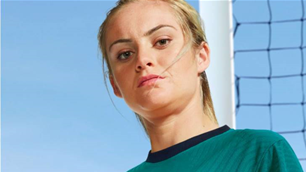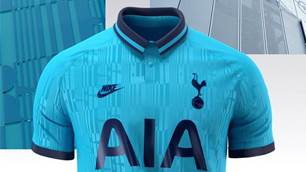HOW does Nike make its boots so grippy, shirts unclingy and footballs so round? FourFourTwo headed to Nike HQ in Portland to find out.
Page 2 of 2 | Single page
World in Motion
When Tiger Woods told Nike he needed better traction on his golf shoes, the boffins called in the greatest golfer ever, stuck little balls all over his body and filmed his swing as a means to produce a better shoe for him to play in.
For football it’s no different. Players such as Ronaldo, Ronaldinho, Ruud Van Nistelrooy, Wayne Rooney and Milan young gun Pato have all visited the Nike Sports Research Lab to have their movements filmed and analysed in the quest to make the perfect football boot.
“Over the last 10 years we have done a series of studies in the lab and on the field with elite players to try and understand exactly how they accelerate on the pitch,” explains Erez Morag, the senior football researcher at the Nike Sports Research Lab. “How they accelerate going forward; how they accelerate with a change of direction. Because that’s what players are doing most in the game and therefore it can affect the outcome of a game.
“It’s very important to listen to the athletes but it’s also just as crucial to look at what they do as well.”
Morag directs our attention over to an athlete standing on a small patch of AstroTurf with reflective balls stuck on his legs and feet. It the famous motion capture machine which films the movement of the reflective balls and can then create a computerised image of that person’s movement to analyse exactly how different footballers accelerate, change direction and strike the ball.
“The studies led to the development of a concept that was uniquely different to what was done before. If you look at the foot, it’s not symmetrical. The medial side is different to the lateral side and so is the movement of both sides in the football during acceleration. So we introduced the concept of asymmetry, with the medial side having a medial function and the lateral side having a lateral function, therefore increasing acceleration.”
If this is all over your head, don’t worry. I was feeling the same way. When it was later explained to me simply, I understood that rather than making a completely flat sole, the boot mirrored the contours of the foot better, allowing for a greater range of movement and ability to accelerate in game conditions. Why couldn’t he have said that in the first place?
Chamber of Secrets
One of the keys for Nike in producing the Socceroos kit is to make a shirt that will keep the players as cool as possible. Research shows that an athlete’s performance begins to degrade when their body temperature hits 39.5°C (42°C is heatstroke and a medical emergency) so in Asian and Australian conditions, it’s paramount their kit is not a hindrance on their performance.
At the Sports Research Lab, they test fabric in what is called an environmental chamber, a room not much bigger than a store cupboard which is set at a constant temperature. Test athletes run on a treadmill for up to 90 minutes with thermal sensors strategically places on their bodies, all to find out where the most heat is generated.
Our guinea pig for the day didn’t seem to have it too bad – jogging at an easy pace while watching Sportscenter on TV – but gathering the data is a serious business.
Our runner’s chest has a temp of 33°C degrees, arms 30°C and stomach 32°C. But the figure that confirms previous research is the heat coming off his back – 34.5°C degrees – hence the advent of mesh panels on the back of the Socceroos kit.
Simple, eh?
Speed Demon
If Nike has learned one thing from all the research it has put into football boot development it’s that speed is king. Acceleration is the act footballers do more than anything else during a game, so making a player faster will give them a competitive edge in a match.
“What we found is that the most important activity in football is acceleration,” says Morag. “That happened on average 58 times in a game. In second place is passing the ball at 24 times a game. So speed is more important than anything else, both from what the athlete is telling us and showing us.”
Designing football boots is hard work. It takes about three years to work on new, innovative products – the boots you saw players wear in the 2006 World Cup finals were being developed in the lab way back in 2003.
The Mercurial Vapor – the orange boot worn by the likes of Cristiano Ronaldo and Tottenham’s Aaron Lennon this season – is Nike’s speed boot, made from lightweight materials and ergonomically designed to fit the foot better.
“We found the players felt more stable because now instead of standing on something, they’re in something,” explains Morag, likening the back of the boot to a racing car’s bucket seat, hugging the heel and stopping it from moving about in the boot.
So wearing this boot will make me as fast as Ronaldo then? “No, In the end it’s down to the players and their performance,” laughs Morag. “Only their ability will make them great players and score the goals but we want to give them every advantage we can on the pitch.”
OK, so maybe not Cristiano, but I’d still fancy my chances against the goofy Ronaldo over 60 yards – I’ll even let him bring his Nike crutches.
There’s always one diva…
“I’m not wearing that kit!” I said.
I’m sure it was the last thing the Nike guys thought they would hear from one of their guests, especially as they had set out an Aladdin’s cave worth of merchandise for us to pick and choose from, including our choice of any football boot they make.
The problem was that the football team I’d been placed in had to wear an Arsenal kit. As a born and bred Tottenham fan, they had more chance of Adi Dassler’s grandson getting a swoosh tattooed on his butt than me going out in that red and white shite.
The already stressed Nike rep nervously laughed, saying that it was just a fun part of the day and we could have a laugh getting a few pictures in the mag.
Suppressing my gag reflex as I walked towards the kit, I kept repeating “5-1” over and over in my head to take my mind off it. “No, I’m sorry, I can’t do it. It’s not going to happen.”
At this point I’m sure the Nike girl would’ve been happier dealing with Cher and Naomi Campbell’s wardrobe issues than with my inbred hatred of Arsenal. But to her credit, she understood the passion that football rivalries spawn and managed to find me a Juventus away kit to wear instead.
One good thing did come out of the kit fiasco and having to play against Arsenal rather than with them: I’ve never enjoyed kicking my opponents in a game more.
Hoop Dreams
I wanted to take in an NBA game while I was in the US, as much to compare the atmosphere and how they present their game compared to the A-League at home as for my love of the game. As luck would have it, LeBron James and the Cleveland Cavaliers were in town to take on the Portland Trailblazers.
The Blazers are like the Central Coast Mariners of the NBA – except their players can understand what their coach is yelling from the sidelines. The town is small in US terms, dwarfed by the larger Seattle in the north, but the team has enjoyed past success with steady ownership and strong ties to the community.
I was steadied for a slick, professional sporting experience, one that would make the still developing A-League product pale in comparison. Instead I was greeted with “Pet Appreciation Day” where fans who sent in pictures of their pets in Blazers gear had them put onto the big JumboTron during breaks in the action. I think even the Mariners would think that was too corny.
Luckily the action on the court was of a higher standard. James – the best player in the league along with the Lakers’ Kobe Bryant – took hold of the game when it mattered, scoring three consecutive three pointers and draining the winning points with 0.3 seconds left. I left the arena feeling like I’d seen a true sporting master at work.
Just like watching Fyfey at Sydney then…
When Tiger Woods told Nike he needed better traction on his golf shoes, the boffins called in the greatest golfer ever, stuck little balls all over his body and filmed his swing as a means to produce a better shoe for him to play in.
For football it’s no different. Players such as Ronaldo, Ronaldinho, Ruud Van Nistelrooy, Wayne Rooney and Milan young gun Pato have all visited the Nike Sports Research Lab to have their movements filmed and analysed in the quest to make the perfect football boot.
“Over the last 10 years we have done a series of studies in the lab and on the field with elite players to try and understand exactly how they accelerate on the pitch,” explains Erez Morag, the senior football researcher at the Nike Sports Research Lab. “How they accelerate going forward; how they accelerate with a change of direction. Because that’s what players are doing most in the game and therefore it can affect the outcome of a game.
“It’s very important to listen to the athletes but it’s also just as crucial to look at what they do as well.”
Morag directs our attention over to an athlete standing on a small patch of AstroTurf with reflective balls stuck on his legs and feet. It the famous motion capture machine which films the movement of the reflective balls and can then create a computerised image of that person’s movement to analyse exactly how different footballers accelerate, change direction and strike the ball.
“The studies led to the development of a concept that was uniquely different to what was done before. If you look at the foot, it’s not symmetrical. The medial side is different to the lateral side and so is the movement of both sides in the football during acceleration. So we introduced the concept of asymmetry, with the medial side having a medial function and the lateral side having a lateral function, therefore increasing acceleration.”
If this is all over your head, don’t worry. I was feeling the same way. When it was later explained to me simply, I understood that rather than making a completely flat sole, the boot mirrored the contours of the foot better, allowing for a greater range of movement and ability to accelerate in game conditions. Why couldn’t he have said that in the first place?
Chamber of Secrets
One of the keys for Nike in producing the Socceroos kit is to make a shirt that will keep the players as cool as possible. Research shows that an athlete’s performance begins to degrade when their body temperature hits 39.5°C (42°C is heatstroke and a medical emergency) so in Asian and Australian conditions, it’s paramount their kit is not a hindrance on their performance.
At the Sports Research Lab, they test fabric in what is called an environmental chamber, a room not much bigger than a store cupboard which is set at a constant temperature. Test athletes run on a treadmill for up to 90 minutes with thermal sensors strategically places on their bodies, all to find out where the most heat is generated.
Our guinea pig for the day didn’t seem to have it too bad – jogging at an easy pace while watching Sportscenter on TV – but gathering the data is a serious business.
Our runner’s chest has a temp of 33°C degrees, arms 30°C and stomach 32°C. But the figure that confirms previous research is the heat coming off his back – 34.5°C degrees – hence the advent of mesh panels on the back of the Socceroos kit.
Simple, eh?
Speed Demon
If Nike has learned one thing from all the research it has put into football boot development it’s that speed is king. Acceleration is the act footballers do more than anything else during a game, so making a player faster will give them a competitive edge in a match.
“What we found is that the most important activity in football is acceleration,” says Morag. “That happened on average 58 times in a game. In second place is passing the ball at 24 times a game. So speed is more important than anything else, both from what the athlete is telling us and showing us.”
Designing football boots is hard work. It takes about three years to work on new, innovative products – the boots you saw players wear in the 2006 World Cup finals were being developed in the lab way back in 2003.
The Mercurial Vapor – the orange boot worn by the likes of Cristiano Ronaldo and Tottenham’s Aaron Lennon this season – is Nike’s speed boot, made from lightweight materials and ergonomically designed to fit the foot better.
“We found the players felt more stable because now instead of standing on something, they’re in something,” explains Morag, likening the back of the boot to a racing car’s bucket seat, hugging the heel and stopping it from moving about in the boot.
So wearing this boot will make me as fast as Ronaldo then? “No, In the end it’s down to the players and their performance,” laughs Morag. “Only their ability will make them great players and score the goals but we want to give them every advantage we can on the pitch.”
OK, so maybe not Cristiano, but I’d still fancy my chances against the goofy Ronaldo over 60 yards – I’ll even let him bring his Nike crutches.
There’s always one diva…
“I’m not wearing that kit!” I said.
I’m sure it was the last thing the Nike guys thought they would hear from one of their guests, especially as they had set out an Aladdin’s cave worth of merchandise for us to pick and choose from, including our choice of any football boot they make.
The problem was that the football team I’d been placed in had to wear an Arsenal kit. As a born and bred Tottenham fan, they had more chance of Adi Dassler’s grandson getting a swoosh tattooed on his butt than me going out in that red and white shite.
The already stressed Nike rep nervously laughed, saying that it was just a fun part of the day and we could have a laugh getting a few pictures in the mag.
Suppressing my gag reflex as I walked towards the kit, I kept repeating “5-1” over and over in my head to take my mind off it. “No, I’m sorry, I can’t do it. It’s not going to happen.”
At this point I’m sure the Nike girl would’ve been happier dealing with Cher and Naomi Campbell’s wardrobe issues than with my inbred hatred of Arsenal. But to her credit, she understood the passion that football rivalries spawn and managed to find me a Juventus away kit to wear instead.
One good thing did come out of the kit fiasco and having to play against Arsenal rather than with them: I’ve never enjoyed kicking my opponents in a game more.
Hoop Dreams
I wanted to take in an NBA game while I was in the US, as much to compare the atmosphere and how they present their game compared to the A-League at home as for my love of the game. As luck would have it, LeBron James and the Cleveland Cavaliers were in town to take on the Portland Trailblazers.
The Blazers are like the Central Coast Mariners of the NBA – except their players can understand what their coach is yelling from the sidelines. The town is small in US terms, dwarfed by the larger Seattle in the north, but the team has enjoyed past success with steady ownership and strong ties to the community.
I was steadied for a slick, professional sporting experience, one that would make the still developing A-League product pale in comparison. Instead I was greeted with “Pet Appreciation Day” where fans who sent in pictures of their pets in Blazers gear had them put onto the big JumboTron during breaks in the action. I think even the Mariners would think that was too corny.
Luckily the action on the court was of a higher standard. James – the best player in the league along with the Lakers’ Kobe Bryant – took hold of the game when it mattered, scoring three consecutive three pointers and draining the winning points with 0.3 seconds left. I left the arena feeling like I’d seen a true sporting master at work.
Just like watching Fyfey at Sydney then…
Related Articles

FFA 'consulting with Nike' on Matildas kit backflip

After eight years, Wanderers swap Nike for Kappa













